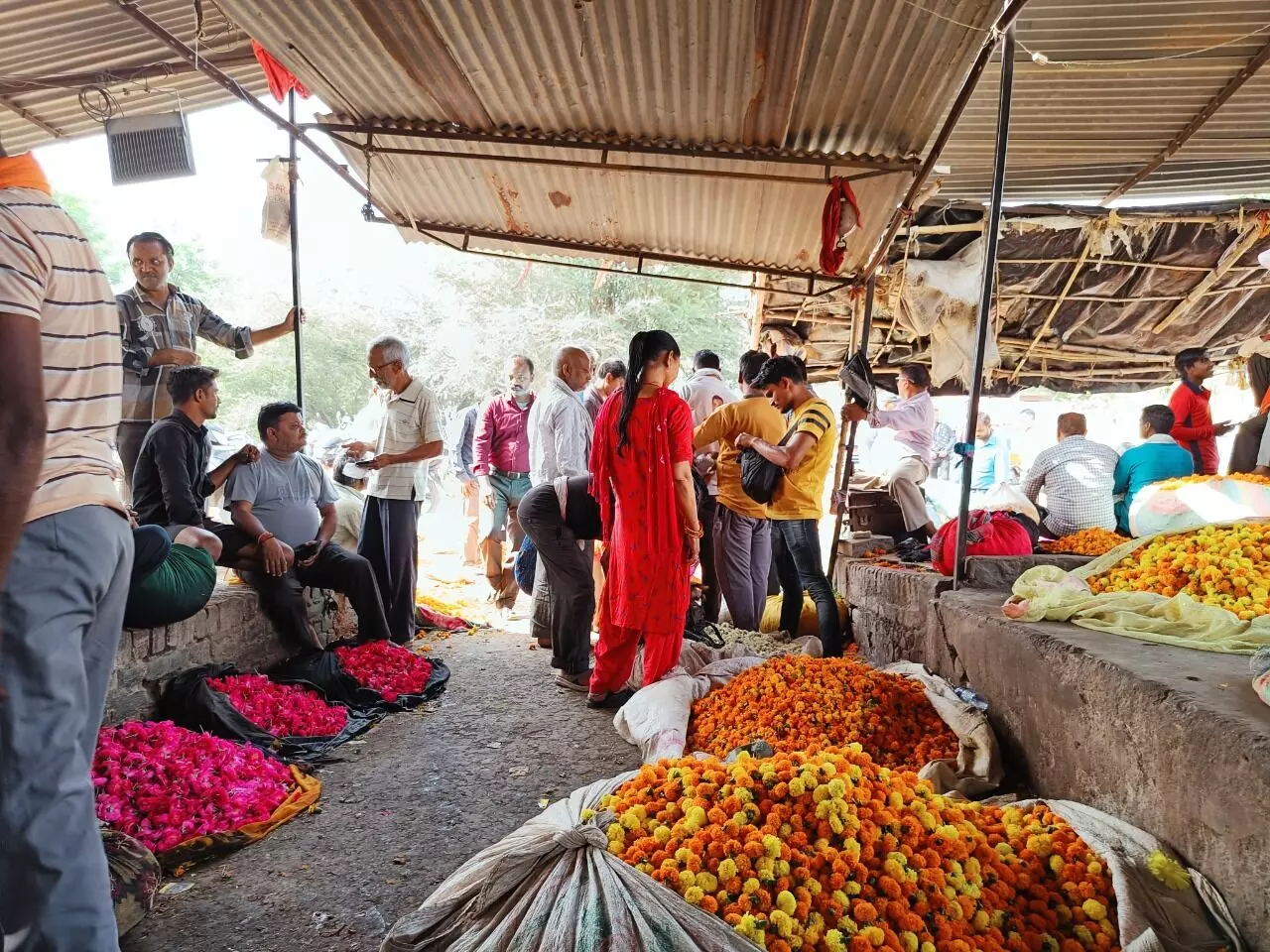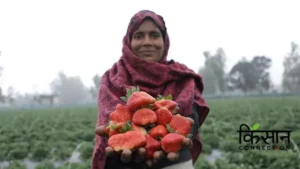Phool Mandi, Lucknow, Uttar Pradesh
Rampal Maurya sat on his haunches next to his mound of marigold flowers spread out on a cloth on the ground. It was 7 am in the Phool Mandi (flower market) of Lucknow and the footfall in the market was gradually increasing.
“People came, saw the flowers and went off without buying,” the 45-year-old Maurya told Gaon Connection despondently. He had set off with his precious burden of flowers at four in the morning and travelled about 22 kms from Amlauli village in Malihabad block, to the flower mandi. But there are no takers for his flowers.
“Everyone is looking for bigger flowers. But this time, because of the heat, the flowers have not grown to their full size. I have grown them with all the care, water and fertilisers, yet they have not grown,” Maurya said helplessly.
Lucknow’s Chowk Phool Mandi, in the old part of the capital city, is perhaps the oldest flower market in Uttar Pradesh. It buzzes with activity as farmers and traders come and go from nearby districts as well. But this year the sales are affected, as the early arrival of summer and the heatwave last month have affected flower production.

Lucknow’s Chowk Phool Mandi, in the old part of the capital city, is perhaps the oldest flower market in Uttar Pradesh.
According to Israr Khan, director of the Lucknow flower mandi, the mandi received consignments of flowers from Narauna, Kakori, Mohan Road, Malihabad, Mal, Bharawan, BKT, and Rae Bareli.
“But because of the heat, the flowers are wilting. The roses are much smaller and it takes nearly a kilo of roses to make a garland,” he pointed out.
Khan also brought up the matter of the rising diesel prices and the added expenditure the farmers were facing transporting their flowers to the market.
Speaking about the impact of the rising heat, SK Tiwari, principal scientist, National Botanical Research Institute, Lucknow said: “This year the temperature touched forty degrees in March itself. The heat is not allowing the flowers to grow to their full size.”
Facing the heat
Not just Maurya, many other flower cultivators are facing the heat, literally. Added to the soaring temperatures is the rising price of diesel, fertilisers, and pesticides that have gone up nearly 20 per cent in the last one year, they complain.
About 330 kilometres away from where Maurya grows his flowers, in the neighbouring state of Madhya Pradesh is Neeraj Tripathi. Tripathi who is from Bagaha village in Satna district, had his own woes. “Last year I bought marigold all the way from West Bengal paying fifty paise per sapling. This year the saplings have cost me one-and-a-half rupees,” the 40-year-old farmer told Gaon Connection.
Tripathi, who has taken land on lease, also spent money to put a tube well on the land. “I irrigate the land over fifteen days usually, but this time I had to do it over a week,” he said. Because of the harvesting of wheat, there is also a shortage of electricity and water, he added. “People prefer buying bigger flowers for weddings, and that is just not happening,” he reiterated what Maurya had said. But, he added that traders from Maihar and Chitrakoot had bought some of the smaller blooms.

Because of the heat, the flowers are wilting.
Also Read: “I am going to plough the flowers down”
Tripathi’s woes don’t end here. He had taken three acres of land on a share-holding basis for which he has to pay Rs 12,000 an acre as rent. He spent an additional Rs 100,000 on the tube well.
“In addition, I spent sixty thousand rupees on fencing the land, sixty thousand on labour and thirty five thousand rupees on sprinklers to water my plants. I paid twenty five thousand rupees for electricity for three months and twenty five thousand rupees on fertilisers and pesticides,” he detailed his expenditure.
Having faced considerable losses in the previous two years because of the pandemic, Tripathi had seen a glimmer of hope of some profits this year from his flowers. But he said his dreams had gone up in smoke.
“Flower cultivation has taken a constant hit. Last year, I had cultivated marigolds in three acres of land, but this time I limited it to one acre only,” the 40-year-old farmer said, but if things continued the way they were, he would stop flower cultivation and grow something else, he added.
The price of flowers are not fixed and they fluctuate depending on their availability in the flower markets, the farmers said.
“Marigolds sold for thirty rupees a kilo today, and roses went for about forty to fifty rupees a kilo,” Israr Khan of the Lucknow flower mandi said. “The price depends on the volume of flowers available in the market,” he added.

Horticulture experts warn that the soaring temperatures could adversely impact flower cultivation.
Soaring temperatures could wilt flower business
Roses, anthurium, carnations, and marigolds are mainly cultivated in India. And, along with growing them in conventional open fields, the flowers are also being cultivated in greenhouses and polyhouses. India exports flowers to various countries including the United States of America, England and the Netherlands. In 2020-21 flowers worth Rs 575.98 crores were exported.
Horticulture experts warn that the soaring temperatures could adversely impact flower cultivation.
“Currently, roses, tube roses and marigolds are growing and they are being affected by the heat. The farmers will be forced to irrigate them more than usual,” SK Tiwari of National Botanical Research Institute told Gaon Connection.
“Many farmers are growing gerberas in polyhouses. Usually it is between mid March and mid May that they need the most looking after and careful attention. But this time the temperatures went up in March itself,” the scientist said.
Ways to combat the heat
“There are ways the farmers can help themselves. Firstly, they should refrain from over-irrigation. Even if the plants seem to wilt in the afternoon sun, do not water them, as that will make them wilt more,” Tiwari cautioned.
He advised the farmers to do mulching on their field with the crop residue from the wheat or with dried leaves, which would keep the soil beneath moist and prevent the water content in the soil from evaporating.
The other menace is that of pests. According to the principal scientist, because the other fields have been harvested, the moisture and the vegetation in the fields of flowers attract pests. “It is important not to just watch the flowers, but to pay extra and careful attention to their roots that are vulnerable to pests,” he advised.


















